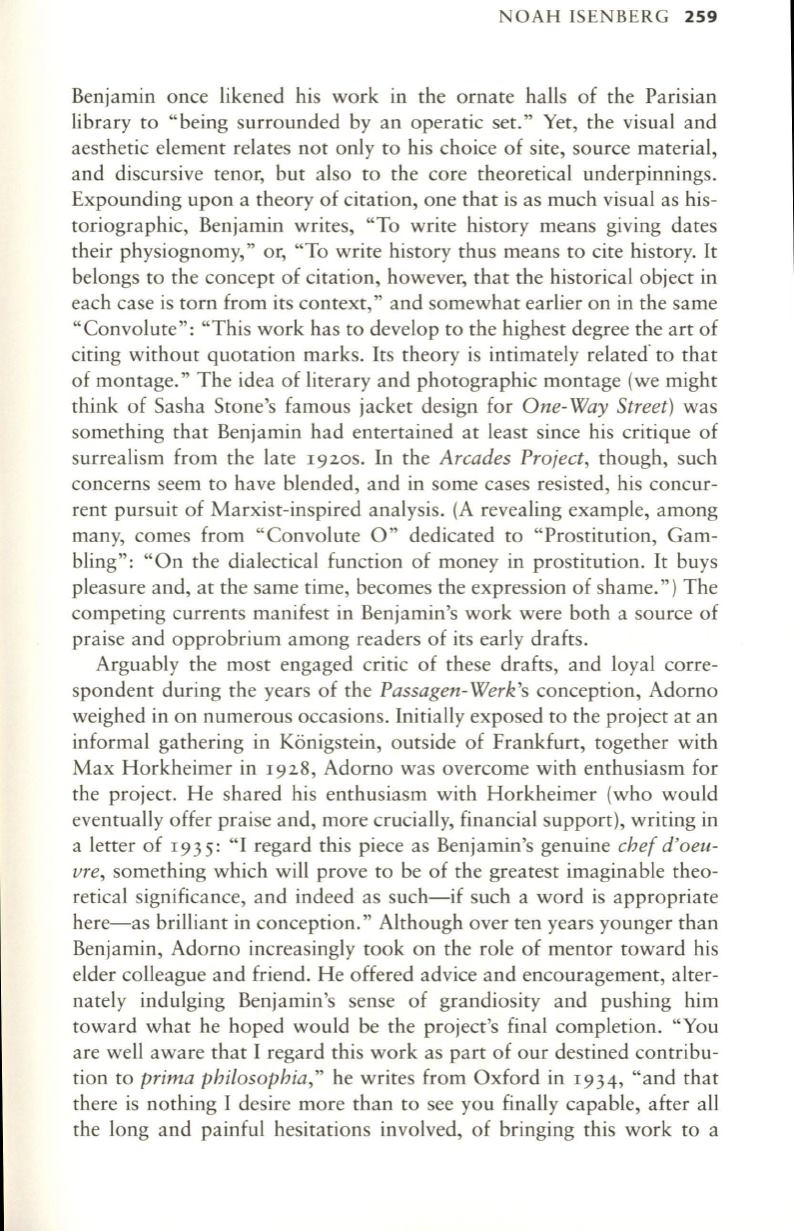
NOAH ISENBERG
259
Benjamin once likened his work in the ornate halls of the Parisian
library to "being surrounded by an operatic set." Yet, the visual and
aesthetic element relates not only to his choice of site, source material,
and discursive tenor, but also to the core theoretical underpinnings.
Expounding upon a theory of citation, one that is as much visual as his–
toriographic, Benjamin writes, "To write history means giving dates
their physiognomy," or, "To write history thus means to cite history.
It
belongs to the concept of citation, however, that the historical object in
each case is torn from its context," and somewhat earlier on in the same
"Convolute": "This work has to develop to the highest degree the art of
citing without quotation marks. Its theory is intimately related" to that
of montage." The idea of literary and photographic montage (we might
think of Sasha Stone's famous jacket design for
One-Way Street)
was
something that Benjamin had entertained at least since his critique of
surrealism from the late
I920S .
In the
Arcades Project,
though, such
concerns seem to have blended, and in some cases resisted, his concur–
rent pursuit of Marxist-inspired analysis. (A revealing example, among
many, comes from "Convolute 0" dedicated to "Prostitution, Gam–
bling" : "On the dialectical function of money in prostitution.
It
buys
pleasure and, at the same time, becomes the expression of shame.") The
competing currents manifest in Benjamin's work were both a source of
praise and opprobrium among readers of its early drafts.
Arguably the most engaged critic of these drafts, and loyal corre–
spondent during the years of the
Passagen-Werk's
conception, Adorno
weighed in on numerous occasions. Initially exposed to the project at an
informal gathering in Konigstein, outside of Frankfurt, together with
Max Horkheimer in
I928,
Adorno was overcome with enthusiasm for
the project. He shared his enthusiasm with Horkheimer (who would
eventually offer praise and, more crucially, financial support), writing in
a letter of
I935:
"I regard this piece as Benjamin's genuine
chef d'oeu–
vre,
something which will prove to be of the greatest imaginable theo–
retical significance, and indeed as such-if such a word is appropriate
here-as brilliant in conception." Although over ten years younger than
Benjamin, Adorno increasingly took on the role of mentor toward his
elder colleague and friend . He offered advice and encouragement, alter–
nately indulging Benjamin's sense of grandiosity and pushing him
toward what he hoped would be the project's final completion. "You
are well aware that I regard this work as part of our destined contribu–
tion to
prima philosophia,"
he writes from Oxford in
I934,
"and that
there is nothing I desire more than to see you finally capable, after all
the long and painful hesitations involved, of bringing this work to a


